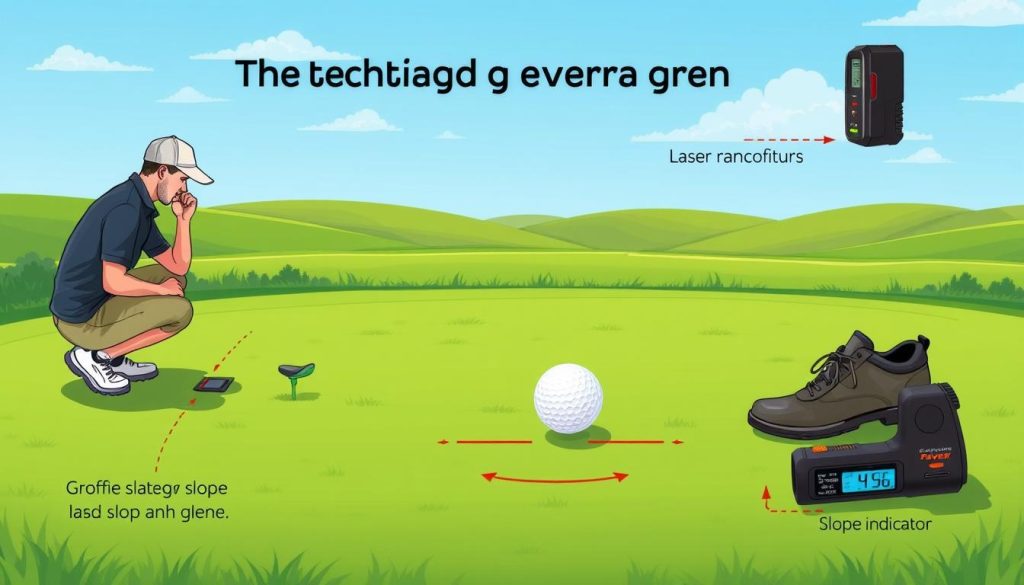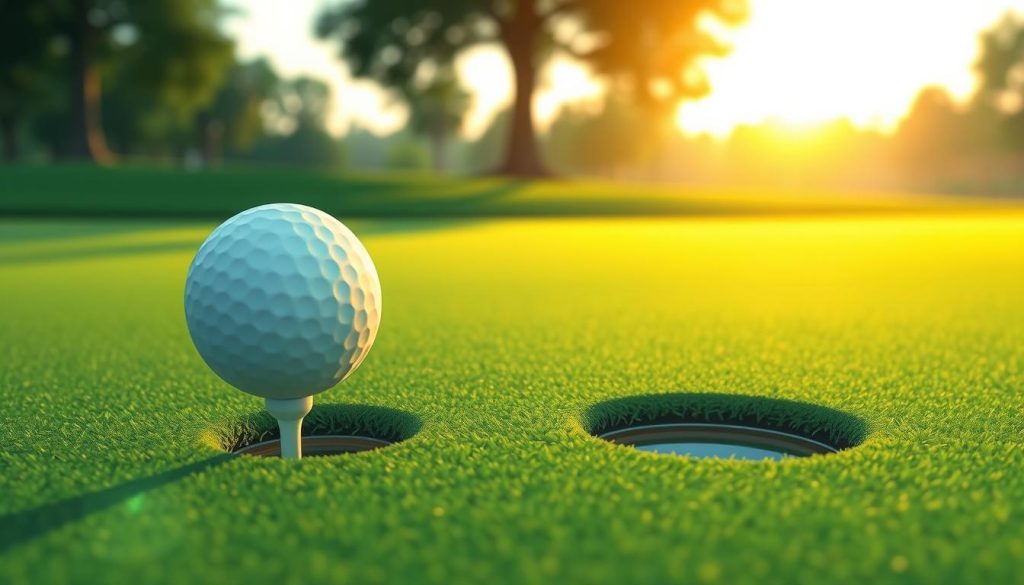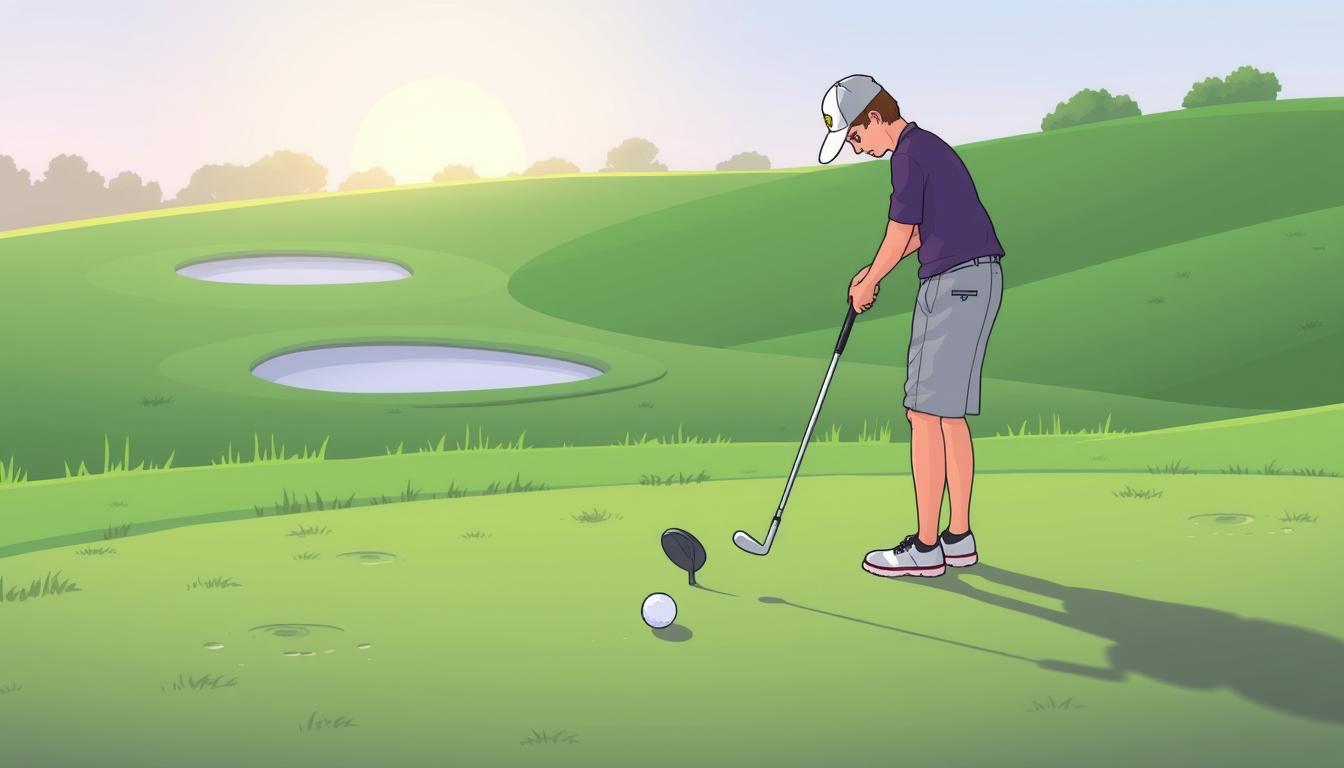Golf putting technique is key to a great game. It needs skill, spatial awareness, and focus. This guide will help you improve your putting.
The perfect putt has three parts: speed, aim, and stroke. Each part is crucial for a successful putt. Mastering these will boost your putting and lower your scores.
Golf putting tests your accuracy and patience on the green. To do well, you must read the green, prepare mentally, and stroke with precision. This guide will show you how to improve your putting skills.
Key Takeaways
- Master the three elements of putting: speed, aim, and stroke
- Learn effective green-reading methods for accurate shot planning
- Understand the importance of proper posture and alignment
- Develop a consistent putting stroke through practice and drills
- Choose the right putter for your style and technique
- Analyze your putts to continually improve your performance
Understanding the Fundamentals of Golf Putting
Golf putting is all about precision on the green. Learning the basics is key to better scores and more confidence. Let’s explore the essential skills needed.
Definition and Basic Concepts
Putting means rolling the ball into the hole from a short distance. It’s about controlling speed and direction with a light touch. The aim is to get the ball in as few strokes as you can, making it vital for your game.
The Role of Precision in Putting
Precision is crucial for good putting. It includes aligning right, having a consistent stroke, and reading the green well. Many struggle with alignment, often because of the wrong putter length or setup. Better setup and alignment can greatly improve your putting.
Key Components of a Successful Putt
A successful putt has several important parts:
- Stable stance and posture
- Proper grip and putter alignment
- Consistent stroke mechanics
- Accurate green reading
- Effective distance control
Tools like mirrors and string lines can help with alignment. Some golfers use putter lines or targets to aim better. Regular practice is key to mastering these skills and improving your game.
Putting Stroke Precision Guide
Mastering the perfect pendulum swing is key to improving your putting game. This guide focuses on essential elements and techniques to enhance your putting precision.
Essential Elements of the Guide
The core components of a precise putting stroke include backstroke length, speed, and timing. These factors work together to create a smooth, controlled motion that leads to accurate putts.
| Distance | Backstroke Length | Speed |
|---|---|---|
| 3 ft hole | 4.5 inches | 1.5 MPH |
| 6 ft hole | 6 inches | 2 MPH |
| 12 ft hole | 8.5 inches | 3 MPH |
Implementing Precision Techniques
To implement putting precision techniques, focus on maintaining a 2:1 ratio between backstroke and forward stroke. This timing helps create a consistent swing path. Using a swing path optimizer can help you visualize and perfect your stroke mechanics.
Common Mistakes to Avoid
Avoid these common putting errors to improve your game:
- Inconsistent technique
- Poor distance control
- Incorrect posture
- Neglecting green reading
By addressing these issues and practicing with purpose, you’ll see significant improvements in your putting performance. Remember, putting accounts for about 43% of shots in a typical round, making it crucial to master these skills.
Mastering the Perfect Putting Stroke Mechanics
Improving your putting stroke is key to better golf scores. Focus on the swing technique to boost your putting. Let’s explore the main parts of a precise putting stroke.
Consistent wrist motion is the base of a good putt. Tour players keep their wrists still, gripping firmly. This makes their putts more accurate and reduces misses.
Tempo is also vital. Top putters swing at a 2:1 ratio, with the backswing longer. They swing at 72 to 80 beats per minute, for a smooth motion.
Using a stroke arc enhancer can improve your putting. It helps you keep a consistent path and angle at impact. This practice leads to a more reliable stroke and better results.
| Putting Element | Pro Golfer Standard | Amateur Goal |
|---|---|---|
| Wrist Motion | Minimal | Reduce Movement |
| Tempo Ratio | 2:1 | Practice 2:1 Rhythm |
| Stroke Pace | 72-80 BPM | Aim for Consistency |
Practice and consistency are crucial for mastering putting stroke mechanics. Work on a steady grip, smooth tempo, and correct alignment. With effort and the right mindset, you can greatly enhance your putting and lower your scores.
Reading the Green Like a Professional
Improving your putting game starts with mastering green reading techniques. Professional golfers use advanced methods to analyze the putting green. They make precise shots based on this analysis. Let’s look at some key aspects of reading greens like a pro.
Understanding Slope and Break
When analyzing the putting green, focus on the slope and break. Look for subtle changes in elevation and grass grain direction. These factors greatly affect how your ball will roll towards the hole.
Green Speed Assessment
Evaluating green speed is key for accurate putting. Professionals use a stimpmeter to measure green speed. A reading around 9.25 indicates medium-fast greens, common in private clubs. Faster greens have less break, while slower ones break more.

Visual Analysis Techniques
Use visual analysis to improve your putting accuracy. Identify the “high point” of your putt, where it starts to break towards the hole. Visualize the ball’s path before your shot. This helps with focus and confidence.
The AimPoint Method
The AimPoint putting method is popular worldwide. It uses your feet to feel the slope and a hand-based system to express steepness. By estimating slope percentage and creating an ‘AimPoint’, you aim your putt more accurately.
- AimPoint is taught in over 40 countries
- It can significantly reduce green reading time
- Suitable for golfers of all skill levels
- Regular practice is key to mastering this technique
By using these professional green reading techniques, you’ll improve your putting precision. This will help lower your scores.
Equipment Selection and Setup
Choosing the right equipment is key to better putting. Putter selection, grip types, and fitting are all important. They help you perform better on the green.
Choosing the Right Putter
When picking a putter, look for comfort and effectiveness. Mallet putters are stable and forgiving. Blade putters give you precise feedback. Think about your putting style and what you like.
Grip Types and Their Impact
Grip types affect your wrist motion and control. Try different grips to find the best one for you. A good grip helps keep your wrists neutral, improving your stroke.
Putter Length and Lie Angle
Fitting your putter is crucial. It should match your body and posture. You want a slight arm bend and comfortable hip flexion. Your eyes should be over the ball.
| Putter Type | Characteristics | Ideal for |
|---|---|---|
| Mallet | Enhanced stability, forgiveness | Golfers seeking consistency |
| Blade | Heightened feedback, precision | Players with a pendulum-like stroke |
Proper putter fitting can improve your aiming. Don’t be afraid to get a custom fitting. It ensures your equipment matches your natural stroke.
Distance Control and Speed Management
Mastering putting distance control and speed management is key to lowering your score. A consistent putting stroke can greatly improve your green performance. Let’s look at some effective techniques to boost your putting skills.
Proper speed control begins with your backstroke. Many golfers face issues due to a slow backstroke and transition. This results in too much speed near impact. The goal is to build enough speed in the backstroke and transition phases for a smooth impact.

To improve your tempo and speed, use tees as markers for drills. Aim for consistent stroke length and tempo for reliable distance control. This method builds muscle memory for a square impact and a consistent putting stroke.
Specialized tools can also enhance your putting. For example, the FinalPutt Putting Bundle includes three essential tools:
- Putting Ruler
- Pro Tutor
- Putting Template
These tools help improve start line accuracy, stroke consistency, and alignment. The Ball Gates, with three sizes, let you adjust difficulty levels for start line accuracy and speed control.
| Tool | Purpose | Benefit |
|---|---|---|
| Putting Ruler | Start line accuracy | Immediate feedback |
| Pro Tutor | Stroke consistency | Path correction |
| Putting Template | Alignment | Proper setup |
| Elevated String Line | Start line accuracy | Visual guide |
By using these tools and techniques in your practice, you can develop a reliable putting stroke. This will improve your performance on the green. Remember, consistent practice with aids leads to a dependable putting technique.
The Science of Backstroke and Follow-Through
Mastering the putting backstroke and follow-through is key to improving your golf game. Understanding the science behind these movements can lead to better putting. It can also boost your performance on the green.
Backstroke Length Guidelines
The length of your putting backstroke affects distance control. Use body landmarks as guides. For instance:
- Inner thigh: 6 paces
- Outer thigh: 9 paces
- Outside pocket: 12 paces
Or, use clubhead widths as a guide. Practice different stroke lengths for various distances. Try 4, 8, 12, or 16 inches to find what works best for you.
Timing and Tempo
A smooth putting stroke depends on timing and tempo. Aim for a 2:1 ratio between backstroke and follow-through. This means your backstroke should be twice as long as your follow-through. This rhythm helps keep your putting consistent and controlled.
Impact Position Control
Proper impact control is crucial for a good ball roll. Focus on these three movements:
- Shoulders rotating around the spine
- Arms flowing freely from the shoulders
- Putter flowing freely from the arms
Avoid stiff arm positions or too much wrist action. Instead, aim for a relaxed stroke. This allows the putter to move naturally, improving your feel and control on the green.
| Putt Distance | Backstroke Length | Body Landmark |
|---|---|---|
| 3 feet | 4.5 inches | Big toe |
| 6 feet | 6 inches | Inner thigh |
| 12 feet | 8.5 inches | Outside pocket |
Training Aids and Practice Tools
Golf training aids have changed how players improve their putting. These tools mix essential practice gear, digital innovations, and alignment aids. They help refine your technique and lower your scores. Let’s look at some top putting practice aids to boost your game.
Essential Practice Equipment
The Wellstroke mat comes in five arc degrees, from 12° to 24°. This lets you tailor your practice to fit your style. The Welltowel, at $39.00, helps with setup consistency.
The Ghost Hole, a $19.00 circular disc, mimics a hole for home practice.
Digital Training Aids
The Vision Stick, at $79.00, is a digital tool for recording and analyzing your putting. It gives instant feedback on your technique. The Wellvision Plus, with two mirrors, helps with consistency and accuracy.
Alignment Tools
The Wellgate, at $29.00, has three golf putting gates for better alignment. The Putting String Line, at $19.00, improves start line and face alignment skills. The Coach Pack, at $89.00, includes a Wellstroke 12° and three Ghost Holes.
These tools offer affordable ways to improve your putting precision.
FAQ
What are the key components of a successful putt?
How long should my backstroke be for different putt lengths?
What is the AimPoint method in green reading?
How do I choose between a mallet and blade putter?
What’s the ideal timing ratio for backstroke and forward stroke?
How can I improve my putting speed control?
What are some effective training aids for improving putting?
How important is the putter’s lie angle?
What is the ideal launch angle for a putt?
How can I use the putting stroke groove tool to improve my stroke?
Source Links
- https://skillest.com/blog/master-the-art-of-golf-putting-a-comprehensive-guide-for-beginners/
- https://back2basics.golf/blogs/news/how-to-nail-your-distance-control-and-putting-stroke?srsltid=AfmBOooL1dDNuf-eKOjpmn5kglcxW1huwCgGLloJREakpAqa6tpNQ1U-
- https://www.golfzongolf.com/blog/technology/the-art-of-putting-in-golf-a-comprehensive-guide
- https://www.scienceandmotion.com/download/docs/fundamentals/The Fundamentals of Putting1.pdf
- https://www.centredegolfvaldesarbres.com/en/precision-on-the-green-the-best-golf-putting-techniques-for-golfers-of-all-levels/
- https://www.pgaplay.co.uk/learn/the-definitive-guide-to-mastering-the-art-of-putting/
- https://sportsedtv.com/blog/the-art-of-perfecting-your-putting-posture-a-guide-for-golfers
- https://hackmotion.com/putting-stroke-tips/
- https://hackmotion.com/best-putting-tips/
- https://www.golfzonleadbetter.com/blogs/putting-tips-how-to-read-a-green/
- https://skillest.com/blog/a-comprehensive-guide-to-aimpoint-golf-putting/
- https://palmbirdputtergrips.com/how-to-improve-putting-consistency-and-performance/
- https://putterhead.com/blogs/news/golf-gear-galore-a-comprehensive-guide-to-equipment-selection-and-maintenance?srsltid=AfmBOooOF98_ABfKbv48d_4ZqCP9vCR4WAEyW7DU7-xxjsaFvzPDjTED
- https://finalputt.com/blogs/how-to-break-80/the-best-putting-aids-to-lower-your-score?srsltid=AfmBOooeIGCvLzZMG0b1afLEBii5sZmS8Vmnp_6OmJTTm4PTQ81Vleaq
- https://visioputting.com/
- https://www.golfsmartacademy.com/golf-instruction/length-of-back-swing/
- https://patch.com/pennsylvania/doylestown/mastering-art-putting-guide-lowering-your-scores
- https://rotaryswing.com/golf-instruction/putting/perfect-putting/perfect-putting-technique-stroke
- https://wellputt.com/us/11-training-aids?srsltid=AfmBOoqTAqMnD0enxAoVwbpmrScd2Ukln9pjR_Q4wIE6LNxYTb94iyxT
- https://mymully.com/blogs/news/the-easiest-way-to-improve-your-golf-game-a-comprehensive-guide-to-golf-training-aids?srsltid=AfmBOorXS8ZjhWTOuAZU1reSgnDssANIHYiCEQbjx6YMZKZXwofBJorW


